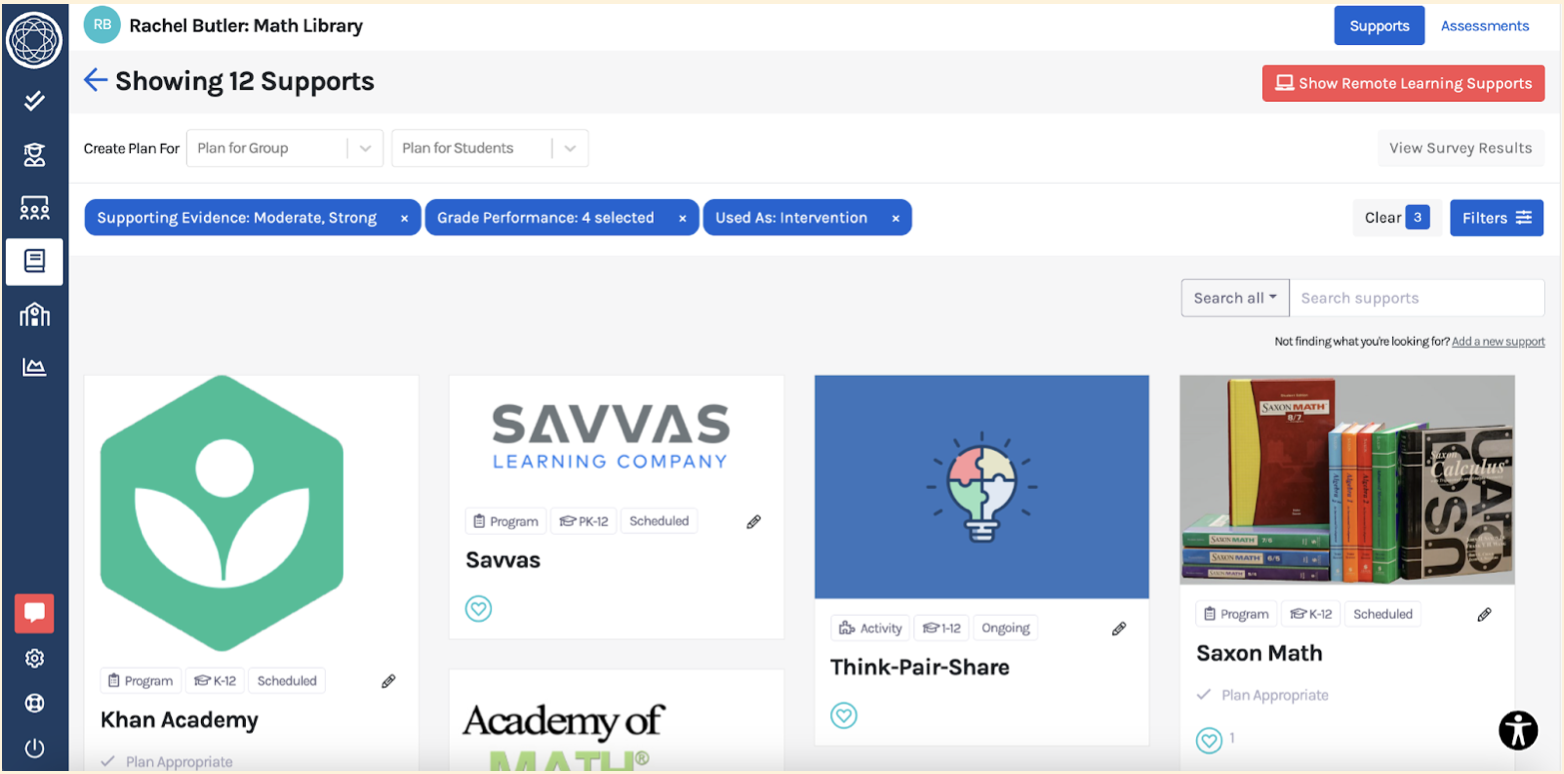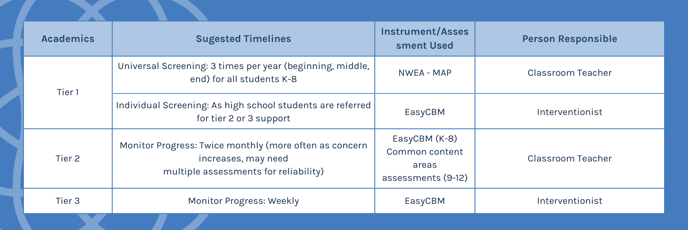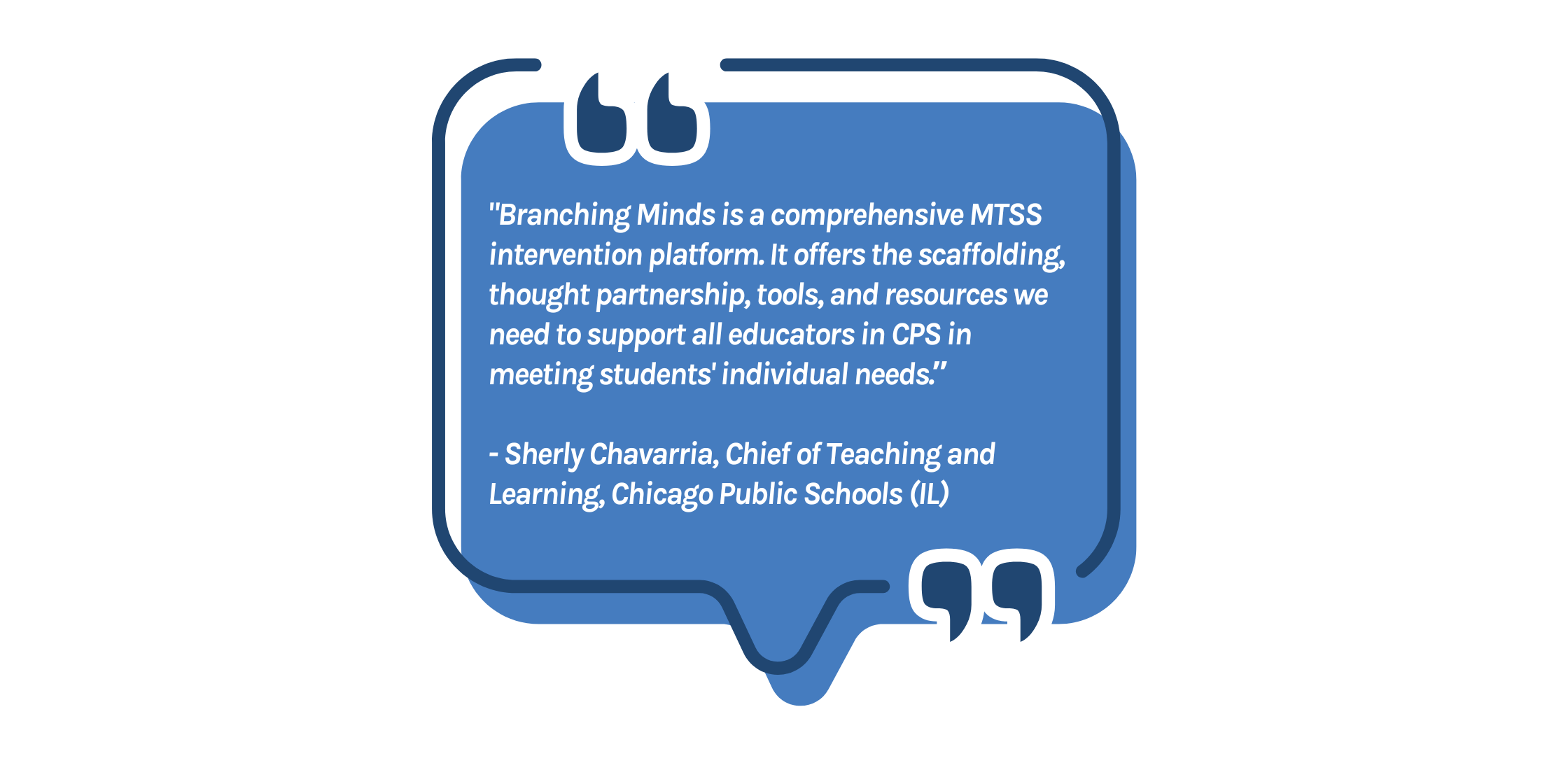In my first year of teaching, I was hired as a special education teacher at an alternative high school on the south side of Chicago. I had a great experience there and truly loved working with high school students. I had never considered myself to be “a math person,” but I ended up enjoying teaching math much more than I expected. What I did not expect was that I would be teaching resource classes for high school seniors who were performing at around a 4th-grade level in math. In this situation, math interventions became my new best friend.
Interventions are key when teaching students who are not performing at grade level. Essentially, interventions are strategies that teach a new skill, build fluency in a skill, or encourage a child to apply an existing skill to new situations or settings. Interventions are chosen specifically for an individual student or a small group of students based on their particular academic needs.
 Top 4 Challenges for Secondary Math Intervention:
Top 4 Challenges for Secondary Math Intervention:
Challenge #1: Finding the Time and Available Staff
Some schools may offer classes specifically for intensive interventions, while some may have a staff member who is hired specifically to implement these interventions. In many cases, special education or general education teachers are tasked with implementing math interventions in the classroom or during intervention blocks. Schools also often face the dilemma of finding available staff who are trained to implement interventions. For this reason, many schools turn to online and computer-based programs to support struggling students. Some great (free!) computer-based mathematical intervention options include Khan Academy and Freckle. These can be highly effective, but remember that many students may still require additional instruction to reinforce what they are learning and practicing online.
Challenge #2: Finding Research-Based Math Interventions
We all know how easy it is to Google teaching strategies or to purchase a teacher-created activity, but how do you know that the intervention has evidence of success? Using a strategy with little or no evidence base can waste valuable classroom time while teachers wait to see if the intervention will succeed over time. To verify if an intervention is research-based, teachers can search for ESSA (the Every Student Succeeds Act) curated interventions. If you are using the Branching Minds support library to select an intervention, you can check the level of evidence and read a summary of the research findings on the support card. Additionally, you can filter the options in our library to ensure you see intervention options with a strong research base.

Challenge #3: Figuring Out If the Intervention is Working
Progress monitoring can also be a big challenge for many educators. Progress monitoring is used to determine how effective an intervention is for your students. The data gathered from progress monitoring helps make decisions like whether the duration or frequency of the intervention needs to be increased, whether the intervention is working or should be swapped for a different intervention method, and if the student has met their goals and the intervention can be discontinued. Students receiving Tier 2 support should be assessed weekly or every other week, while students receiving Tier 3 support should be assessed weekly. Branching Minds has put together a sample progress monitoring schedule for reference.

Challenge #4: Motivating and Engaging Students
Some students may lack motivation in math class, especially students who already feel they are struggling or falling behind. This can be another serious challenge – it can feel pointless to set up and follow through with interventions for students who don’t seem to be putting in any effort. I was this student when I was in high school. I didn’t feel like a “math person,” it seemed like all of my peers were miles ahead of me in math class, and I started to resist any efforts to help me. It felt hopeless. But there were a few things my teachers did to motivate me, and a few more strategies I’ve learned about in my time in education.
- Develop meaningful and respectful relationships with students. This can start to sound cliche (how many times do teachers hear “relationships first!”?) but it is honestly a great place to start. Each student will require different motivational strategies, and you have to know them, their interests and hobbies, their family situations, and what excites them in order to figure out which strategies might work.
- Promote a growth mindset. Growth mindset, a concept pioneered by American psychologist Carol Dweck, is the belief that our intelligence and abilities can be developed over time. It means that we are eager to learn, capable of adapting, find value in facing challenges, and believe that effort can improve our skills. This was part of my problem as a frustrated math student! I had a fixed mindset, believing that I was born without math abilities and that I would never be good at it. Fostering a growth mindset in the classroom can start simply, like giving praise for effort and hard work. For example, instead of saying, “You are so good at linear equations!” try saying something effort-based like,“I can tell you’ve been practicing these types of problems.” Teachers can also support a growth mindset by modeling it themselves. Ask students for feedback on your teaching strategies and be willing to make adjustments. This demonstrates that even teachers are learners and that teachers are right there with them putting in the work to improve.
- Create a safe classroom environment. If a student doesn’t feel that a classroom is a safe place, they won’t feel comfortable taking risks or making mistakes. One way to work towards this goal is to develop a community of learners in your classroom. Allow students to help each other, ask questions of their peers, and work together to solve problems. Displaying student work in the classroom can help them to feel included and proud of their work. Teachers can also make an effort to use language that promotes the idea of a community of learners – like saying “we” and “our” rather than “I” and “you”.
- Set high expectations and high goals. Set the expectations high and provide lots of support and encouragement for students as they work to reach those goals. Secondary students will appreciate transparency, and working towards daily, weekly, and yearly goals provides a purpose for the work they are doing.
Secondary Math Intervention Resources and Examples
- Cognitive and Metacognitive Problem-Solving Strategy
- This strategy involves students first learning a 7-step process for solving word problems and then using a 3-part coaching routine for each of the 7 steps. This strategy helps students to employ metacognitive skills to analyze problems, select an appropriate strategy to solve that problem from an array of possible alternatives and monitor the problem-solving process to ensure that it is carried out correctly.
- Math Self-Correction Checklist
- With this strategy, teachers analyze a student’s pattern of errors commonly made when solving math problems and create a brief, customized checklist for that student. The student then uses this to self-monitor and correct their performance on math problems before turning them in.
- Using Question-Answer Relationships (QARs) to Interpret Math Graphics
- Some students may misread or misinterpret math graphics. The QAR strategy, a reading comprehension strategy, can be really helpful for this. Essentially, the QAR strategy teaches students to distinguish among different types of graphics, interpret the information in the graphics, use Question-Answer Relations (QAR) to identify the type of math question being asked and use the QAR to interpret the graphic.
- Peer-Partner Teaching
 With peer-partner teaching, teachers place students into groups or pairs with their peers who are struggling with a similar concept or skill. Students then take turns teaching math concepts to their partners. This strategy is effective because explaining new material to someone else helps students to consolidate the information in their minds. In addition, this strategy has the benefit of promoting social skills, communication skills, empathy, and perspective-taking.
With peer-partner teaching, teachers place students into groups or pairs with their peers who are struggling with a similar concept or skill. Students then take turns teaching math concepts to their partners. This strategy is effective because explaining new material to someone else helps students to consolidate the information in their minds. In addition, this strategy has the benefit of promoting social skills, communication skills, empathy, and perspective-taking.
In Conclusion
For best results with math intervention, keep the individual student in mind and tie in their interests and strengths as much as possible. Ensure that the intervention is research-based, implement it with fidelity, and follow up with progress monitoring. And if you’re working with an especially closed-off or challenging student, don’t give up on a specific intervention too quickly! Stick with it until the data shows you it’s time to try something else. Consistency is vital and is often the secret to success.
- Check out the Branching Minds Library of Supports! Request a demo today.
- And, for more support and guidance with the how-tos of implementing an intervention, check out BRM’s MTSS Intervention Process Flowchart.
Key Takeaways:
- Educators should always make sure that the interventions they select are research-based.
- Progress monitoring data helps educators decide whether the intervention's duration or frequency needs to be adjusted, whether the intervention is working or should be swapped for a different intervention method, and if the student has met their goals and the intervention can be discontinued.
- For students struggling with motivation, teachers should try to develop meaningful relationships, promote a growth mindset, create a safe classroom environment, and set high expectations and goals.
👉 Download The MTSS Intervention Flowchart Guide
Citations:
Study.com. (2012). Academic Intervention: Definition, Plan & Strategies. Retrieved from https://study.com/academy/lesson/academic-intervention-definition-plan-strategies.html
Branching Minds. (n.d.). The Guide to Solving the Top Four MTSS Challenges. Retrieved from https://www.branchingminds.com/mtss-challenges-guide
Intervention Central. (n.d.). Applied Math Problems: Using Question-Answer Relationships (QARs) to Interpret Math Graphics. Retrieved from https://www.interventioncentral.org/academic-interventions/math/math-problem-solving
Intervention Central. (2020). Response to Intervention | Math | Math Problem Solving: Combining Cognitive-Metacognitive Strategies. Retrieved from https://www.interventioncentral.org/academic-interventions/math/math-problem-solving-combining-cognitive-metacognitive-strategies
Intervention Central. (n.d.). Self-Monitoring: Customized Math Self-Correction Checklists. Retrieved from https://www.interventioncentral.org/academic-interventions/math/self-monitoring-customized-math-self-correction-checklists
Spruell, S. (n.d.). How to Develop a List of MTSS Interventions for the 2022-2023 School Year. Retrieved from https://www.branchingminds.com/blog/how-to-develop-a-list-of-interventions-mtss
The Decision Lab. (n.d.). Growth Mindset. Retrieved from https://thedecisionlab.com/reference-guide/neuroscience/growth-mindset
Wilcox, L. (2018, June 4). Top 5 Strategies for Motivating Students. NBPTS. Retrieved from https://www.nbpts.org/blog/top-5-strategies-for-motivating-students/
About the author
Branching Minds
Branching Minds is a highly respected K-12 services and technology company that leverages the learning sciences and technology to help districts effectively personalize learning through enhancements to their MTSS/RTI practice. Having worked with hundreds of districts across the country, we bring deep expertise in learning sciences, data management and analysis, software design, coaching, and collaboration. Combined with our extensive toolkit of resources, PD, and technology, we provide a system-level solution. We are more than a service or a software provider, we are partners who will deliver sustainable results for educators, and a path to success for every learner.

Your MTSS Transformation Starts Here
Enhance your MTSS process. Book a Branching Minds demo today.

















